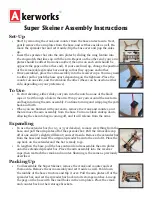
PDFMAILER.DE
DIAGNOSIS CHART
6
Step
Test operation
Correct condition
Defect condition
1.
Step LCD, LED
test.
Turn on the power
switch while
pressing
“REVERSE”, AUO-
LOCK”, THEN
PRESS “1” within 2
seconds.
1. LCD shows (Special
Mode).
2. LCD shows (Self-Check
Start).
3. Buzzer sounds.
4. The 6 LED blinks.
Press Enter to the next test.
If the machine does not go to
Test mode, replace the
following parts in order and
recheck
1. Printed circuit board F
2. Printed circuit board K
3. Printed circuit board A
4. Printed circuit board L
2. Step Keys
Press the keys shown
below in order.
“Reverse, Auto-Lock,
U/D, Twin Needle,
Width -, Width +,
Length -, ,
Clear, Enter, Turn-
Over, Memory, Mode,
and stitch patterns 1
to 0.
1. Buzzer sounds.
2. LCD shows (Key).
3. Each time you press the
key, buzzer sounds.
4. It goes to the Step (3)
automatically if in correct
condition.
If buzzer does not sound when
you press the key, replace the
following parts in order and
recheck.
1. Printed circuit board F.
2. Printed circuit board K.
3. Printed circuit board A.
3. Step
Buttonhole.
1. Pull down the
buttonhole lever.
2. Move the
buttonhole lever
back and forth.
1 Buzzer sounds and LCD
shows (BH Sensor L).
2 LCD shows (BH Sensor
H) when the sensor is
closed.
3 LCD shows (BH Sensor
L). when the sensor is
open.
If machine does not work
properly, replace the following
parts in order and recheck.
1. Buttonhole sensor.
2. Printed circuit board K.
3. Printed circuit board A.
4. Step Bobbin
winder switch.
1 Shift the bobbin
winder spindle to
the right.
2 Shift the bobbin
winder spindle to
the left.
1. Buzzer sounds each time
and LCD shows (Spool).
If not working, replace the
following parts in order and
recheck.
1. Printed circuit board K.
2. Printed circuit board A.
5. Step Tension
switch.
1 Turn the thread
tension dial.
1 Buzzer sounds and LCD
shows (Thread Tension).
2 LED turns on when the
dial is state “Auto”.
3 LED turns off when dial is
turned from “Auto”.
If not working, replace the
following parts in order and
recheck.
1. Printed circuit board K.
2. Printed circuit board A.
3. Printed circuit board L.
6. Step Upper
shaft sensor.
1 Turn the balance
wheel toward you
to move the needle
bar from the
highest to the
lowest position,
then from the
lowest to the
highest position.
1 Buzzer sounds and LCD
shows (PH Sensor L,H).
2 LCD shows (PH Sensor
L,H), when the needle bar
is moved from the lowest
to the highest.
3 LCD shows (PH Sensor
H,L), when the needle bar
is moved from the highest
to the lowest.
If not working properly, replace
the following parts in order
and recheck.
1. Upper shaft sensor.
2. Printed circuit board A.
7. Step Stepping
motor for
zigzag.
1 Turn the balance
wheel toward you
to move the needle
bar from the
highest to the
lowest position.
Then press
“Reverse” key.
1 Buzzer sounds and LCD
shows Zigzag motor.
2 The stepping motor
moves to the primary
setting position.
If not working, replace the
following parts in order and
recheck.
1. Stepping motor for zigzag.
2. Printed circuit board A.
8. Step Stepping
motor for feed.
1 Turn the balance
wheel toward you
to move the needle
bar from the
highest to the
lowest position.
Then press
1 Buzzer sounds and LCD
shows (Feed motor).
2 The stepping motor
moves to the primary
setting position. (feed at
“O”).
If not working properly, replace
the following parts in order
and recheck.
1. Stepping motor for feed.
2. Printed circuit board A.









































